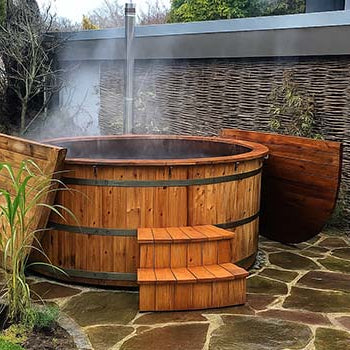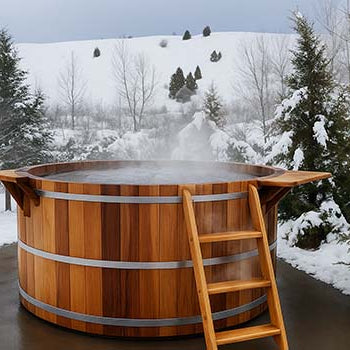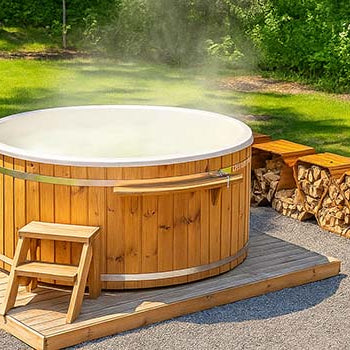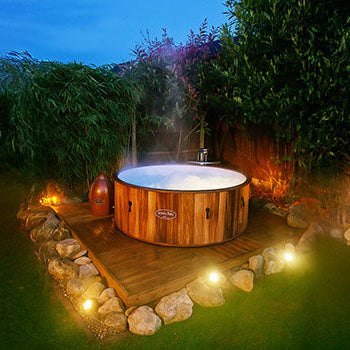Ever feel guilty leaving your hot tub running like it’s part of the furniture? You’re not alone. It’s a hot topic (pun intended) for UK owners wondering if switching it off after every dip saves money, or just creates more hassle. Short answer? It’s usually cheaper to leave it on, especially if you’re using it more than twice a week.
Why? Because reheating cold water costs more energy than gently maintaining heat. From how Acrylic, Rotomoulded, or even Wooden Hot Tubs behave in our chilly UK climate, this guide spills all the secrets to soaking smart. Let’s dive in.

Heating vs. Maintaining: Understanding Hot Tub Energy Use
Running a hot tub isn’t just about hitting the ‘on’ button. Energy use depends on what your spa’s doing, and reheating from scratch isn’t the same as keeping it warm between sessions.
The Energy Spike of Reheating Cold Water
Imagine preheating your oven from cold every single time you cook. That’s what happens when your tub cools right down. Reheating from 10°C back to 38°C uses a serious power surge. It may take hours and gulp more energy than a steady, low burn.
The Consistent Lower Draw of Maintaining Temperature
Now imagine keeping soup warm on the hob. It’s just ticking over. That’s what your hot tub does when it’s left on. Once it hits your desired temperature, it only uses small top-ups of heat. Most Acrylic and Rotomoulded models handle this effortlessly, especially with modern insulation.
The Constant Factor: Heat Loss to the Environment
Even the best hot tubs lose heat to the air, especially in winter. But here's the kicker: it's cheaper to gently top up lost heat than start from zero. That’s why steady maintenance wins out for frequent users, particularly in the UK climate.
Why Constant Temperature is Usually More Efficient (Especially in the UK)
In a country where “four seasons in one day” isn’t a joke, holding a stable water temperature just makes sense. The cold creeps in fast, so you either fight it little by little or go all-in every time.
The Critical Role of Modern Insulation Standards
Acrylic Hot Tubs these days come with serious thermal armour. Think multi-layer foam, sealed bases, and thick shells. That means the heat stays in, and your bills stay down. You’re not heating the whole garden, just the tub.
How Efficient Heaters and Smart Thermostats Help
Today’s tubs aren’t clueless about temperature. Smart thermostats learn your schedule, so they only use what’s needed. Some even heat up just in time for your post-work soak, keeping costs low without sacrificing comfort.
Reducing Strain on Components vs. Frequent Reheating Cycles
Heating coils and pumps aren’t built to yo-yo all day. Constantly heating from cold puts extra wear on your system. Leaving your spa on protects the hardware and avoids surprise repair bills down the line.
Considering Typical UK Ambient Temperatures Year-Round
Let’s be honest, UK weather rarely offers a “tub-friendly” climate. Whether it’s frosty mornings or surprise summer rain, your hot tub has to work hard to recover from cold spells. Maintaining warmth throughout the week can use less energy than restarting daily.

Insulation: The Deciding Factor
Here’s where things get real. If your hot tub’s insulation is poor, leaving it on all the time could cost more. But if it's well-built? That steady hum becomes your savings engine.
How Well-Insulated Tubs Retain Heat Effectively
Top-end Acrylic or Rotomoulded tubs are built like a Thermos. With dense foam and sealed sides, they trap heat and slow down loss, even when it’s freezing out. Consistency is key.
Why Poorly Insulated or Inflatable Tubs May Differ
Got a Wooden Hot Tub or an inflatable one? These can be heat sieves. Without decent insulation, leaving them on all day is like heating a tent. If you only hop in once a week, turning it off might be smarter.
Never Underestimate a Good Quality Thermal Cover
Here’s the easiest fix: a solid thermal cover can cut heat loss by up to 90%. That’s not a typo. Don’t let your hot tub sleep uncovered, it’s like leaving the fridge door open all night.
Exceptions to the Rule: When Turning Down or Off Might Save Money
Let’s not pretend one rule fits all. If you’re more of a weekend-only bather or heading away for a while, there are clever ways to cut costs without sacrificing spa life.
Long Absences (More Than a Few Days)
Heading out for a long trip? Drop the temp by 10°C or use the tub’s ‘sleep mode’ to avoid unnecessary heating. Just schedule the warm-up in advance so it’s ready when you return.
Very Infrequent Use Patterns
If your spa time is more “once a fortnight” than “every Friday night,” consider switching it off. It’ll take longer to heat back up, but you’ll save more over time. Just don’t forget to keep the water treated and covered in between.
Utilising Built-In Economy or Sleep Modes
Many modern tubs come with clever settings to help you save. Eco modes drop the temp during off-peak hours, while still letting you schedule warm-ups before a planned dip. Handy, right?
Recommendations for UK Hot Tub Owners
So, what’s the takeaway if you’re in the UK and love a good soak? Simple: use your tub smartly, not sporadically.
For Regular Use: Maintain Temperature (or Slightly Lower)
Dipping in three times a week or more? Then yes, keep the temp steady. Lower it by a couple of degrees between sessions if you like, but don’t let it drop too far.
Leverage Energy-Saving Modes When Appropriate
Use built-in eco settings whenever possible. They’re designed to work with your routine, not against it. Set it and forget it.
Always Keep the Cover Securely Fitted
The golden rule: never leave your hot tub uncovered when not in use. It’s an open invitation for heat loss, debris, and higher energy bills.

Conclusion: For Most UK Owners, Leaving It On is Cheaper
If you use your hot tub a few times a week and it’s well-insulated, keeping it running is almost always more efficient. You’ll avoid the big energy spikes and save your components from extra wear.
But if you only use it occasionally, have minimal insulation, or are heading out of town, consider eco mode or even switching off until you're back.
Either way, knowledge is your best energy-saving tool. Match your usage to your strategy, and enjoy the bubbles without the bill shock.









